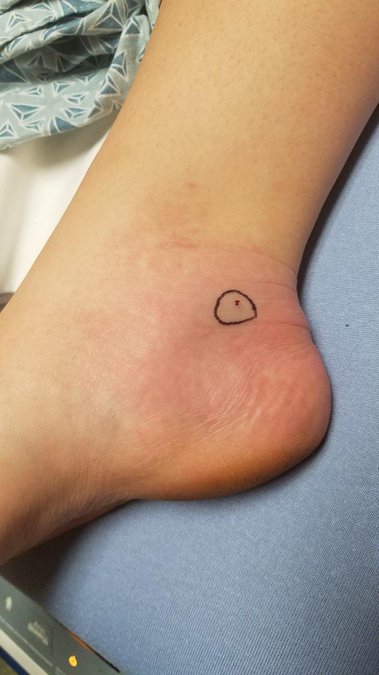On Sunday evening, McKenzie Holbrook, 18, went to get into her dad’s truck, when she felt a sharp pain in her ankle.
“She was actually just leaving the house to get in my truck and go to a friend’s house, and as she approached my truck, she said she felt like something bit her and she looked down and it was a snake,” said Paul Holbrook, her father. “Of course, my wife went and saw it, and it was a copperhead that had bitten her.”
Holbrook said his daughter was immediately in tears after the bite and was taken to Northside Hospital Forsyth to treat the injury.
“They gave her pain medication and monitored her for about four hours,” he said. “After about 2.5 hours, her ankle finally stopped swelling, then [Monday,] it turned a dark, bluish-black color.”
Dr. Douglas Olson, medical director for Northside Forsyth’s emergency department, said the hospital treats bites every year, with copperhead bites being the most common.
“Typically these bites are painful, so a lot of the time they’ll realize they have envenomated,” Olson said. “The tricky part: there are some patients who come in who don’t even realize that they were actually bitten by a snake initially. Let’s say they’re walking through the woods or going through tall grass, they might not even feel the bite initially. They might not even realize they were bit by a snake until they start feeling the pain, then, of course, they see the puncture wound.”
John Jensen, a wildlife biologist with the Georgia DNR specializing in reptiles and amphibians, said there are 46 species of snakes in Georgia, though only six of those are venomous. Of those six, only three — copperheads, timber rattlesnakes and pigmy rattlesnakes — are found in Forsyth County.
That makes treating bites easier since all three are in the pit viper subfamily and use the same antivenom for bites. Jensen said that makes the oft-given advice to identify or capture snakes after someone has been bitten a non-issue.
“That may have been the case in the distant past, but right now, all pit vipers bites in the state of Georgia are treated with the same antivenom, it’s called CroFab,” he said. “It doesn’t matter if it’s a copperhead, cottonmouth or rattlesnake, you treat it with the same stuff, so absolutely don’t put yourself in harm’s way trying to identify a snake after you’ve been bitten.”


Both Jensen and Olson gave similar advice if bitten: immediately seek medical attention.
“If you get bit, the best thing to do and really the only thing you should focus on is getting to an emergency medical facility and having a doctor treat it,” Jensen said. “There’s nowhere in Georgia that’s so remote you don’t have time to get to a hospital if you’re snake bitten.”
Olson said hospital staff works with poison control once the patient comes in.
“Northside has an envenomation protocol, which I was part of making, of the different labs we order, medications we give, antivenom doses that we give,” he said. “We also typically will contact poison control to make them aware we have an envenomation and they will oftentimes follow along and ask if we’re giving it or not or what they would recommend, just so we’re 100 percent up to date.”
Other common pieces of advice worth ignoring, according to Olson, are attempting to suck the venom out of the bite or icing the wound.
“That venom can go through mucous membranes and then affect the person that sucked that venom out, so we don’t want to do that,” Olson said. “Secondly, don’t ice it. It does not deactivate the venom, and it can actually cause localized frostbite.”
Jensen said victims of snake bites should also remove any jewelry from the affected area as soon as possible.
“If it doesn’t get removed, it’s going to get cut off at the hospital, probably,” he said. “It seems maybe counterintuitive to remove constricting things because a lot of people believe you’re supposed to put a tourniquet on and keep the venom contained in the area, and that’s actually the absolute worst thing that you can do for a bite because it is tissue-destroying venom, and the last thing you want to do is concentrate tissue-destroying venom in one spot.”
While copperheads are one of the most common types of snakes in the area, their behaviors should also be noted.
The most common time of the year for copperheads to come out is from mid-spring to mid-fall, when weather is warmer and they appear to be more common after rainy weather. They also try to avoid the high temperatures this time of year.
“Copperheads, once it gets to be really hot in the summer, they switch from being mostly active in the day to mostly being active at night,” Jensen said.
Jensen said there is an average of about five fatal snake bites each year, typically from those that keep them as pets or those under the influence of drugs or alcohol. Accidental bites, like the one over the weekend, are rare.
“The number of snake bites that are truly accidental is really low. It sounds like a truly accidentally snake bite,” he said. “Most of them, people have already seen the snake and they choose a course of action that puts them closer in contact with the snake whether they’re trying to catch it, kill it, move it, whatever.”
Holbrook said for his daughter’s bite, it appeared only one fang got her. The bite didn’t require antivenom and the family was lucky for that.
“They said it would have been a lot worse had both [fangs] gotten her,” he said, “so we’re kind of thankful about that.”
Check out the FCN's guide to snakes in Forsyth County here.



